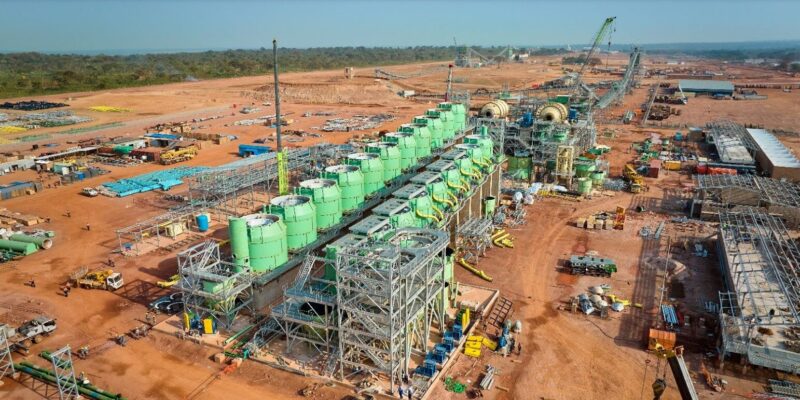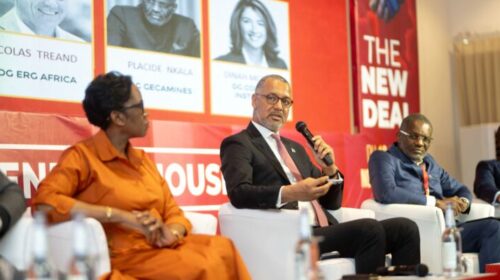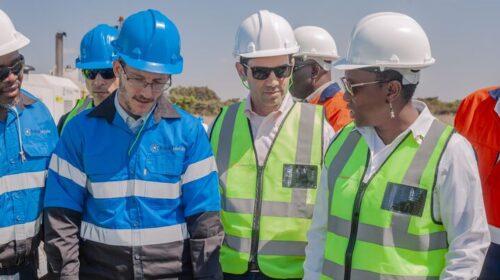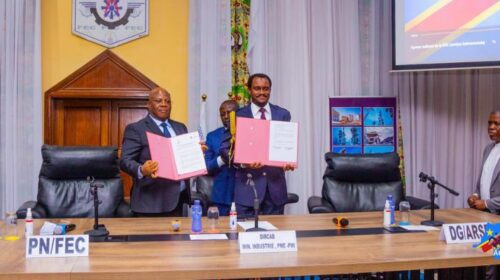The quarterly production record at Kamoa-Kakula was achieved despite continued intermittent grid instability
Since late Q4 2022, Kamoa Copper has been working alongside DRC’s state-owned power company, La Société Nationale d’Electricité (SNEL), to identify the causes of instability across the southern DRC’s grid infrastructure to assist with delivering long-lasting solutions. Kamoa Copper has identified a series of upgrades and has outlined a project plan to deliver the improvements. Mobilization of resources is underway, with vendor selection and equipment procurement having commenced.
Concurrently, Kamoa Copper’s engineering team are working towards insulating Kamoa-Kakula from future instability by expanding on-site backup generation capacity, as well as sourcing additional power imported from the Zambian grid, with negotiations nearing completion for initial provision of 30 MW.
Over the next 12-18 months, on-site backup-power generation capacity will increase via a phased rollout. The current installed on-site backup-power generation capacity is approximately 48 megawatts (MW). Delivery of a further 30 MW in backup generation capacity, sufficient to power Kamoa-Kakula’s entire Phase 1 and 2 operations in the event of grid disruptions, will commence later this year and be fully commissioned in the first quarter of 2024. Over 130 MW of further backup generation capacity has been ordered and is expected to be installed in 2024, in time for the completion of the Phase 3 concentrator and smelter that are currently under construction.
Discussions are advancing to secure up to 100 MW of additional power via the Zambian grid interconnector.
Draw-down of surface ore stockpiles at Kakula continues as required. While the ongoing expansion of underground infrastructure at the Kakula mine takes place, ore will be drawn as required from the stockpile to maximize copper production.
Kamoa-Kakula’s high- and medium-grade ore surface stockpiles totaled approximately 4.1 million tonnes at an estimated grade of 3.6% copper as of the end of September 2023 and contained more than 144,000 tonnes of copper. The operation mined 2.2 million tonnes of ore grading 5.6% copper in Q3 2023, which was comprised of 2.0 million tonnes grading 5.4% copper from the Kakula mine, including 1 million tonnes grading 7.1% copper from the mine’s high-grade centre.
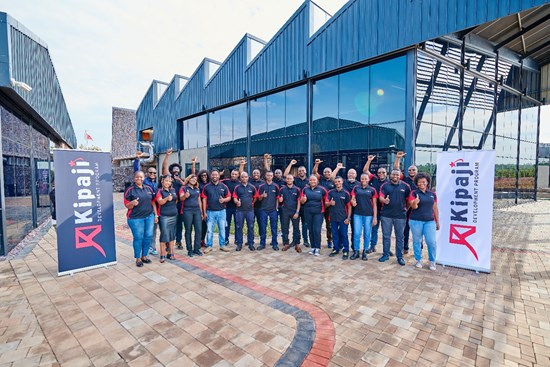
The 2023 Kipaji group kicked off their “High Flyer Management Development Program” in late October. Kamoa’s Kipaji program offers courses that focus on leadership.
Construction of the Phase 3 concentrator plant and associated infrastructure advancing ahead of schedule
Kamoa-Kakula’s ongoing Phase 3 concentrator expansion now is expected to be commissioned in Q3 2024 and includes a new 5-Mtpa plant at Kamoa, which is approximately 10 kilometres north of the Phase 1 and 2 concentrators.
The process design of the Phase 3 concentrator is very similar to that of the Phase 1 and 2 concentrators, but 30% larger. The front end of the concentrator (stockpile, crushing and screening) is being built to a capacity of 10 Mtpa, double the required capacity for Phase 3, in anticipation of the future Phase 4 expansion. This follows the same construction approach as Phase 1 and Phase 2. The bulk of the equipment is the same or similar to that installed in the Phase 1 and 2 concentrators, resulting in a commonality of spare parts, while also leveraging prior operational and maintenance experience.
Following the commissioning of Phase 3, Kamoa-Kakula will have a total design processing capacity of 14.2 Mtpa. The completion of Phase 3 is expected to increase annualized copper production to an average of approximately 620,000 tonnes per year over the next ten years, which will position Kamoa Copper as the world’s third-largest copper mining complex in 2027, and the largest copper mine on the African continent. See Figure 1.

Figure 1: World’s projected top 10 copper mines in 2027, by key metrics.
Note: Kamoa-Kakula production and grade are based on the Kamoa-Kakula 2023 PFS. The ‘Cu Head Grade’ for the projects benchmarked by Wood Mackenzie reflects the average reserve grade. Source: Wood Mackenzie, 2023 (based on public disclosure, the Kamoa-Kakula 2023 PFS has not been reviewed by Wood Mackenzie).
Kamoa-Kakula’s Phase 3 expansion, consisting of two new underground mines known as Kamoa 1 and Kamoa 2 and a new 5-Mtpa concentrator plant, is well on track for first production in the fourth quarter of 2024. Construction of the twin declines to the Kamoa 1 and Kamoa 2 underground mines and excavation to access the Phase 3 mining areas is advancing well. The Kamoa 1 and Kamoa 2 mines share a single box cut with a twin service-and-conveyor decline.
The main access tunnels (drives) between the Kamoa 1 and Kansoko declines for the Phase 3 development now are connected (holed) in the centre of the deposit, a major achievement and milestone for the project team and the underground mining crews as it opens the mine’s footprint for ventilation and marks entry into higher-grade ore from both sides of the deposit.

Construction crews lift the first shell section of the secondary ball mill into place at Kamoa-Kakula’s Phase 3 concentrator site.

Construction of the concentrate thickener is progressing well at Kamoa-Kakula’s Phase 3 concentrator site. The process design of the Phase 3 concentrator is very similar to that of the Phase 1 and 2 concentrators, but 30% larger.
Phase 3 concentrator project 62% complete and ahead of schedule for start-up in Q3 2024
As at October 30, overall project progress of the Phase 3 concentrator is now approximately 62% complete. Production is on budget and well ahead of schedule for Q3 2024. Copper in concentrate produced during the ramp-up period from Q3 2024 onwards will partly be sold to generate additional cash flow, and partly stockpiled in anticipation of the smelter commissioning.
Detailed engineering design and procurement activities are essentially complete, with fabrication activities well advanced. The rate of equipment deliveries to site is steadily increasing. A total of 1,980 truck deliveries have already arrived and been offloaded, with a further 274 en-route to site.
Civil works are now effectively complete, with nearly 30,000 cubic metres of concrete poured to date. The steel, mechanical, piping and plate work (SMPP) contract was awarded during the second quarter, and delivery of structural steel commenced. Over 6,300 tonnes of the required 7,400 tonnes of structural steel and plate work have been shipped to site.
The last lot of the 1,830-tonne primary and secondary ball mill equipment package from CITIC Heavy Industries of Henan province, China, has arrived at site except for the secondary mill feed chute, which is expected in the fourth quarter.
Installation of the first of the two ball mills has commenced at the Phase 3 concentrator site, with flotation cell installation also underway. The first lots of cone crushers, flotation cells, vibrating screens, concentrate filters, cyclone cluster, compressor and pump mechanical equipment packages are now on site or expected to be delivered to site imminently.
Smelter project is 62% complete and on target for commissioning in Q4 2024
The Phase 3 expansion also includes the integration of Africa’s largest direct-to-blister flash smelter, which will have a capacity of 500,000 tonnes of 99+%-pure blister copper anodes per annum. The onsite smelter is being built adjacent to the existing Phase 1 and Phase 2 concentrator plants. The smelter will incorporate leading-edge technology supplied by Metso Outotec of Espoo, Finland and will meet the world-leading International Finance Corporation’s (IFC) emissions standards.
Detailed engineering and procurement activities for the smelter are nearing completion. More than 11,000 tonnes of the total 25,000 tonnes of structural steel have been delivered to site and structural steel erection is well underway. Overall mechanical and electrical equipment fabrication is 70% complete.
Civil construction is nearing completion with structural steel erection and mechanical equipment installation well underway. Approximately 2,000 construction workers are now working at the smelter site, and the workforce is expected to peak at 3,000 in February 2024.
Kamoa-Kakula’s Phase 3 expansion includes the refurbishment of Turbine #5 at the Inga II hydroelectric power station. The turbine will supply an additional 178 MW of clean hydroelectric power to the national grid, which is sufficient to meet the power requirements of the Phase 3 concentrator, and the flash smelter. Study work is also progressing well to upgrade the transmission capacity of the existing grid infrastructure between the Inga II hydropower facility and the Kamoa site. The 99.7% pure blister anode copper produced from Kamoa-Kakula’s smelter is expected to be among the lowest carbon-dioxide emitters in the world per tonne of copper produced.
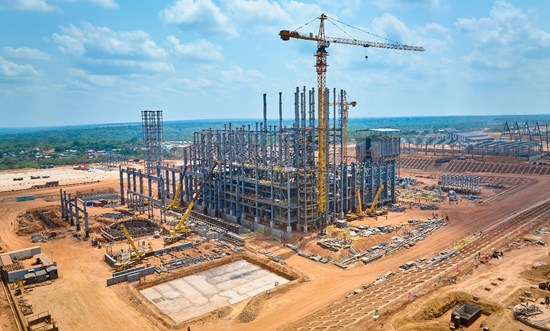
Construction of Kamoa-Kakula’s Phase 3 direct-to-blister smelter furnace is progressing on schedule for completion in Q4 2024. It will be Africa’s largest copper smelter.
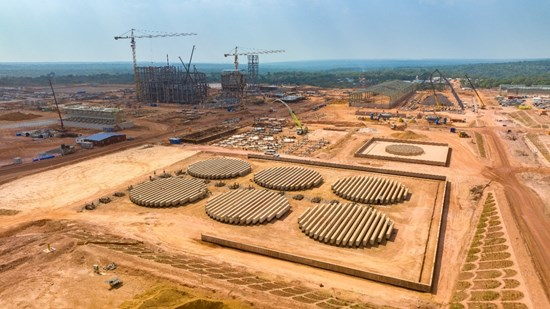
The foundations and civil construction for the Phase 3 smelter’s high-strength sulphuric acid storage tanks are now complete. As a by-product, the smelter will produce between 650,000 to 800,000 tonnes per year of high-strength sulphuric acid, which is planned to be sold domestically.
The smelter will have a processing capacity of approximately 1.2 Mtpa of dry concentrate feed and is designed to run on a blend of concentrate produced from the Kakula (Phase 1 and 2) and Kamoa (Phase 3 and planned Phase 4) concentrators. Under the Kamoa-Kakula 2023 Integrated Development Plan, the smelter is projected to accommodate approximately 80% of Kamoa-Kakula’s total concentrate production. Kamoa-Kakula will also continue to toll-treat concentrates under a 10-year agreement with the Lualaba Copper Smelter (LCS), located approximately 50 kilometres from Kamoa-Kakula, near the town of Kolwezi. Deliveries to LCS are expected to account for approximately 150,000 tonnes of copper concentrate annually.
As a by-product, the smelter will also produce in the region of 650,000 to 800,000 tonnes per year of high-strength sulphuric acid. There is a strong demand for sulphuric acid in the DRC, as it is used to leach copper from oxide ores through the SX-EW (solvent extraction and electrowinning) process. The DRC market consumed approximately 6 million tonnes of acid in 2022. The vast majority of the consumed high-strength sulphuric acid is imported by regional consumers in the form of sulphur and burned in domestic acid plants.
The on-site smelter will offer transformative financial benefits for the Kamoa-Kakula Copper Complex, most notable being a material reduction in logistics costs, and to a lesser extent reduced concentrate treatment charges and local taxes, as well as revenue from acid sales. Logistics costs accounted for 32% of Kamoa-Kakula’s total cash costs (C1) during Q3 2023, and the volume of shipments is expected to halve following the smelter start-up as trucks will transport 99+%-pure blister copper anodes instead of concentrate with approximately 50% contained copper. According to the Kamoa-Kakula 2023 Prefeasibility Study, smelting on-site is expected to drive a decrease in average cash costs (C1) over the first five years post-completion (from 2025) by approximately 20%.
Phase 3 direct-to-blister flash copper smelter will be one of the world’s largest copper smelters and also one of the greenest
According to the assessment completed by Skarn Associates and WSP Group, the smelter will have one of the world’s lowest Scope 1 and 2 GHG emission intensities. As shown in Figure 2, the smelter is estimated to produce 0.36 CO2-e / t Cu. Out of the approximately 100 copper smelters analyzed globally, the smelter is estimated to rank fourth lowest in terms of GHG emissions.
![]()


